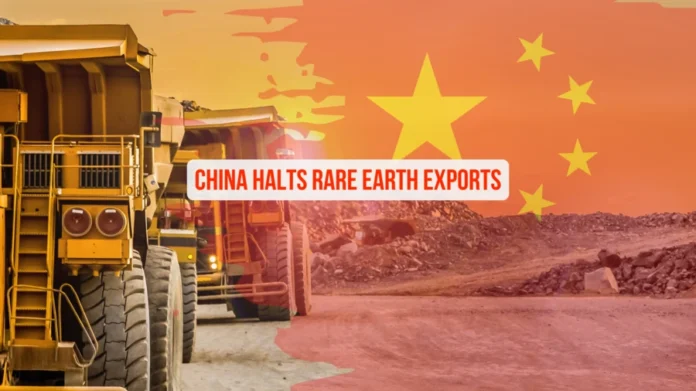Table of Contents
Overview
On April 11, 2025, China imposed new export controls on seven critical rare earth elements, pausing shipments pending government-issued licenses. This action is widely viewed as a strategic response to recent tariff escalations by the United States, marking a significant development in the ongoing trade conflict between the two global powers.
The Export Suspension: What’s Affected
The rare earth minerals affected by China’s export pause include:
- Samarium
- Gadolinium
- Terbium
- Dysprosium
- Lutetium
- Scandium
- Yttrium
These elements are essential to several high-tech and defense applications. Industries most at risk include:
- Consumer electronics (smartphones, laptops)
- Defense (missile guidance systems, radar technology)
- Automotive (electric vehicle batteries)
- Renewable energy (wind turbines, solar inverters)
China’s Position in the Rare Earth Market
China currently dominates approximately 90% of global rare earth production, giving it significant leverage over critical supply chains. The latest restrictions are not a complete export ban but introduce a licensing framework that can be used to restrict or delay shipments to specific countries.
This marks the second high-profile export control action from China in under a year, following similar restrictions on gallium and germanium in 2024.
Motivation Behind the Move
The decision is widely interpreted as a direct reaction to increased tariffs imposed by the United States, intensifying an already strained trade relationship. Analysts suggest that this is a tactical maneuver rather than a long-term policy shift.
According to The New York Times and The Economic Times, the move is aimed at signaling Beijing’s readiness to leverage its control of critical resources as a tool in trade negotiations.
Global Impact
The suspension has already triggered concerns across global markets:
- Supply chain disruptions are expected in the coming months, particularly for sectors heavily dependent on rare earths.
- Commodity prices for these minerals are likely to rise as buyers rush to secure limited supplies.
- Stock market volatility has been observed in tech and EV sectors following the announcement.
Several countries, including the United States, Japan, and members of the European Union, are reviewing contingency plans to diversify their sources of rare earths. However, experts warn that establishing new supply chains could take years.
Long-Term Outlook
While some mining and processing projects are underway outside of China—in Australia, Canada, and Africa—none are positioned to fully replace China’s output in the short term.
This development underscores the urgent need for governments and industries to:
- Diversify mineral sourcing
- Invest in domestic rare earth processing infrastructure
- Develop recycling capabilities for rare earth-containing devices
Frequently Asked Questions (FAQs)
1. Why are rare earth elements so important?
Rare earths are critical for manufacturing components used in electronics, renewable energy systems, advanced defense technologies, and electric vehicles. Their unique magnetic and conductive properties make them irreplaceable in many applications.
2. Is this a complete ban on exports?
No, China has not issued a complete ban. Instead, exports of the seven named elements will now require special licenses. This gives the Chinese government greater control and flexibility in directing supply.
3. What are the immediate effects on global industries?
Industries reliant on rare earths may face increased costs and potential production delays. Companies are likely to accelerate efforts to secure alternative suppliers or re-evaluate production timelines.
4. Can other countries compensate for the loss of Chinese supply?
In the long term, yes—but not immediately. While rare earths are found globally, China’s dominance lies in its well-developed processing infrastructure and lower production costs. Building equivalent capacity elsewhere will require time and significant investment.
5. What does this mean for consumers?
In the near term, consumers may see price increases in electronics and electric vehicles. Longer-term effects will depend on how quickly alternative supply chains can be developed.
Conclusion
China’s suspension of rare earth exports adds a new layer of complexity to an already fragile global trade environment. While not a full-scale embargo, the move has far-reaching implications for technology, defense, and energy sectors worldwide. It also highlights the strategic importance of mineral resources in 21st-century geopolitics.
As the situation evolves, governments and industries are likely to revisit their supply chain strategies and take steps toward reducing dependence on a single source.
Stay tuned to Metavint for updates on global trade developments and their impact on the future of technology.



